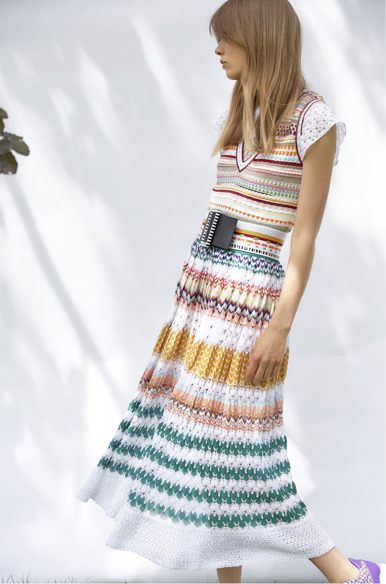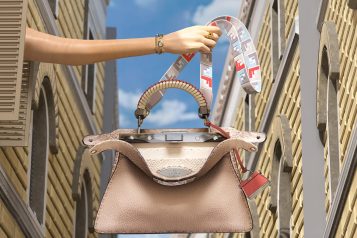
Angela Missoni, who modernized her family’s fashion label and made it a global brand, looks back-and forward-as she celebrates 20 years at the helm.
***
“I always knew my parents were different,” said Angela Missoni, who will celebrate 20 years as creative director of the family’s renowned fashion firm in 2017. She is speaking, of course, of her father and mother, the pioneering designers Tai and Rosita Missoni, who redefined high-end knitwear with a signature pattern style that become a favorite of the European jet set (Marcello Mastroianni and Rudolf Nureyev were early fans) and helped put Italian ready-to-wear on the fashion map. Remarkably, Missoni knits have remained as relevant today for fashion elites as they were when first introduced in the 1950s, and that’s thanks in no small part to Angela’s ability to intuit the fashion zeitgeist and reposition the brand with a modern, bohemian-meets-luxe aesthetic that has resonated with new generations of customers.
As a youngster she may not have fully understood just how her parents were different—Rosita made her clothes, but that wasn’t so unusual in Italy at the time. However, the fabrics, those first renderings of what became the Missoni trademark style, certainly were. “And there were always interesting people around,” she recalls, referring to the family home, first in Gallarate, then in Sumirago, both country settings north of Milan where her parents had invited artists, writers, actors, journalists, and noted Italian cultural figures. This wasn’t suburbia Italian-style, as her classmates knew it. Angela also saw firsthand the hard work that went into growing a family business, which began in the basement of their home. “I remember going to the fairs,” she says of the Italian shows that were essential showcases for newbie designers, and her parents’ tireless hands-on approach—no job was too big or too small for them to tackle. “My father once took a table from his office and roped it to the roof of his car so he could use it at an exhibition,“ she says. Angela adds with a laugh, “Maybe that wasn’t so fashionable, but it was what he needed.”
Beyond the do-it-yourself moments, the story of how the Missoni label came into being is one of Italian fashion’s most venerated tales. There was romance—Rosita Jelmini, a convent school girl, traveled with a chaperone to the 1948 Olympics in London and met the dashing Tai Missoni (whom Sharon Stone once called the handsomest man in the world), a track star competing in 400-meter hurdles for Italy. Despite the 11-year age difference, they wed. There was serendipity—Tai, who designed the Italian Olympic team’s uniforms in 1948, had a burgeoning interest in the sportswear business. The Jelmini family produced shawls and embroidered fabrics, and with their manufacturing savvy, helped the young couple set up a knitwear studio, where they experimented with knitting techniques and designs. Ultimately the Missonis used the machines and looms for making shawls to create the distinct zigzag patterns that would come to define the brand. There was daring—Tai, the family’s color genius, looked far afield for design inspiration, referencing everything from Abstract Art to Aztec fabrics, and gave Missoni pieces a look that was as coveted as a Pucci print. There was also some major fashion drama along the way. At a make-or-break show in Florence in 1967, Rosita asked her models to remove their bras—she felt they showed too prominently under the Lurex knit dresses she had designed. When the models strutted down the runway, breasts visible to all, the room went silent; half the audience was bemused, the other half shocked (remember this is 1967, a year before the worldwide youthquake began). Thanks to the cause célèbre that ensued, the Missonis weren’t invited back, but news about their alluring style began to travel at high speed through the then much smaller fashion world. There was a modicum of luck too. The ultimate fashion deity at the time—Diana Vreeland, editor-in-chief of Vogue, heard about the Missonis when another fashion legend, Consuelo Crespi, a Rome-based editor for the publication and a fixture on best-dressed lists, introduced her to them and their collections. Vreeland famously commented on their work, “Who said that there are only seven colors in the rainbow? There are tones!” and quickly presented the couple to a who’s who of American retailers, buyers, and press.

While Angela grew up in the family business, it wasn’t a given she would work in it. Very early on she demonstrated that shevery much had a mind of her own; her resolute lifestyle choices would first steer her away from the company, then later convince her parents that such moxie (along with her talent) were what was needed to move Missoni forward. During a period when women were entering the workforce in record numbers (although in Italy more slowly than in the U.S.), she put family first, marrying (Marco Maccapani) at 23, having three children, and leading a boho lifestyle far from Milan’s fashion whirl, which included raising chickens and founding a nursery. Although not in the business and not eager to join it, she and her young brood remained close to the clan, living near the family compound in Sumirago.
It was only when her children entered school that she began to consider designing. She first created jewelry for Missoni, then launched her own line, the Angela Missoni Collection, a label where there wasn’t a squiggly line or zigzag pattern to be found. Even if her designs were all about solids, something the Missoni label most definitely was not, her parents liked what they saw. Around the same time, Tai and Rosita felt the brand had plateaued, its message overshadowed in a decade where grunge and stark minimalism dominated fashion headlines. Rosita wanted a fresh take and vision for the label. “My mother was feeling trapped by the commercial side,” Angela says. “She was being asked to repeat and repeat what they had done before. So there was little time to show something new.”
Rosita also felt strongly that to succeed in the fast-changing landscape of 1990s fashion, you had to be “young and passionate,” and to do that “you had to have the strength to fight for your ideas against the commercial side.” She had seen that grit in her daughter, the young woman who unflinchingly opted for a country lifestyle when her peers worldwide were putting on business suits and climbing the corporate ladder. She told Angela, “You have the age and the courage to do this.” The Missonis gave their children control of the company in 1996, with eldest son Vittorio heading up the business side; Angela, overseeing the main women’s ready-to-wear line; and Luca, creating events and eventually the menswear collection.
Even with her parents’ full vote of confidence, taking the reins of such a well-known label had to be a daunting step. Not all storied brands, whether in fashion, publishing, music, or other fields, can move with the times—their essence defined by or reflecting specific moments in contemporary culture. I asked Angela if she had any particular strategy for revitalizing Missoni or any qualms about the position before she took it over. “The modernity was always there,” she explains, but it was like the proverbial light hidden under the bushel. “Collections had the seeds of contemporary costume, but they were submerged by all the history of Missoni. I went straight for what I saw, choosing the stronger points to redefine the image, pulling out one thing at a time in each show to make a difference.”
Every successful fashion house has its own aesthetic language and identifiable markers, and for many Italian labels (think Pucci with its dramatic color swirls and Etro with its paisleys), that language begins with fabric. Although solids defined Angela’s first ready-to-wear, she embraced the label’s legacy of rich, iconoclastic pattern. “Missoni has a big design vocabulary, a certain way of mixing and matching. My parents invented this language. My job has been to update the lexicon,” she explains.
When asked what was the best piece of business advice her parents gave her, she says it had more to with evolving creatively than with tips for increasing market share. “My father (Tai died in 2013 at the age of 92) was more of an artist; he really didn’t care about fashion itself. He trusted me and what I was doing, and pushed me. He always said, ‘You need to go your own way and not be a follower.’ He appreciated I had no fears. My mother didn’t tell me what to do either, although she never agreed with my choice of shoes! I used to say to her, ‘I was born with high heels and you were born with flats.’ But when I took over, it was a different moment in fashion. Girls were sexier in the ’90s than they were in the ’70s.”

Like many designers, Angela’s collection and fabric design ideas come from a wide range of sources: travel, cinema, and art being the most common catalysts for fresh thinking. Her own personal style icons include, in addition to her mother, Rosita, whom she describes as “one of the most exquisite, sophisticated, elegant and stylish women today,” fashion editors like Carine Roitfeld and the legendary Claude Brouet, who headed up French Marie Claire, and actress Diane Keaton in her Annie Hall period. She says the vast Missoni archive is rarely a starting point—she prefers to look forward rather than back, and has no qualms about adding items to collections and to the “lexicon” that have never been part of the label’s language. “Sometimes I will hear that this piece or that piece is not Missoni. If I put it in there, it’s Missoni,” she says.

Under Angela and Vittorio’s watch, Missoni grew from an international brand to a global one, producing some 25 collections each year. Credit them with introducing the hugely successful M Missoni line, one designed for younger audiences at more affordable price points, a menswear and swimwear collection, and for forging buzzworthy collaborations with Target (the pieces sold out in 30 minutes) and Converse. After handing over design duties to Angela, matriarch Rosita focused on expanding Missoni Home, also a highly successful line that helped pave the way for a series of Missoni hotels.
Angela says that after 20 years as chief designer, making the clothes for the collections remains her favorite part of the job. “But I can spend only a quarter of my time on that,” she says. “Recently I have had to work more outside the studio. I love to put together a show, to define the show, to follow the (advertising) campaign and everything that concerns the image of Missoni.” Being detail-obsessed, she confesses, is how she gets it all done.
As she crosses the two-decade mark, Angela won’t speculate on her own future. “Twenty years, I don’t believe it,” she says. She hasn’t ruled out transitioning into another significant creative role within the company one day, as her mother did with Missoni Home. And she is grooming candidates for when she’s ready to pass the baton. An often-talked-about successor is her photogenic daughter Margherita, founder and designer for Margherita, a childrenswear line (and an international It girl). But she has also said that her other daughter, Teresa, son Francesco, or a nephew could land the top job as well.
Until that time, Angela Missoni remains dedicated to keeping her parents’ brilliant creation modern and relevant in an era when fashion, on social media steroids, moves faster and faster each year. “I am focused on building a brand that resonates with consumers today,” she says. “When designing for Missoni, I don’t think of age—just cool, modern silhouettes and patterns—so there are many things that women in their 20s, 30s, 40s, 50s, 60s would want. And my mother too.”



















